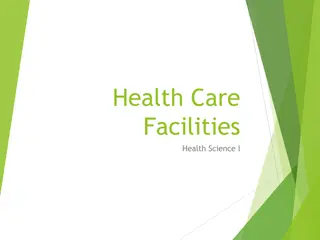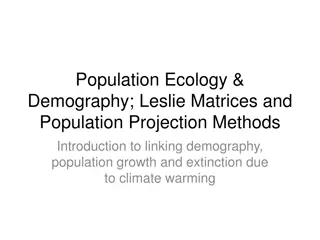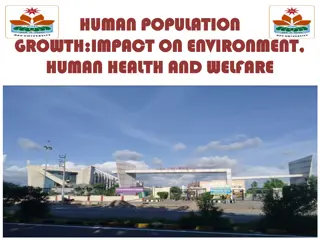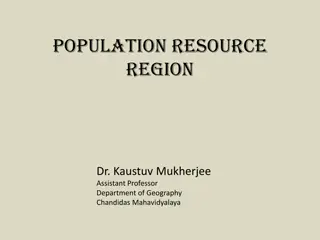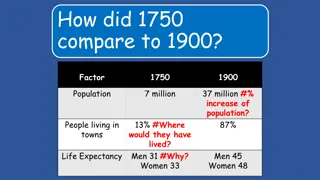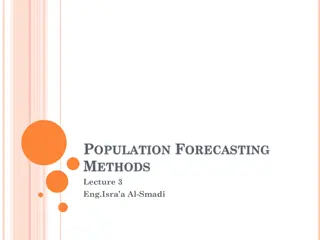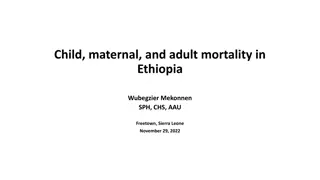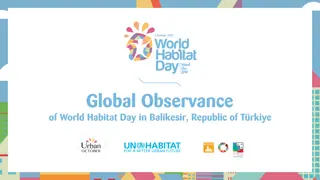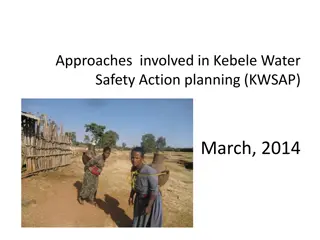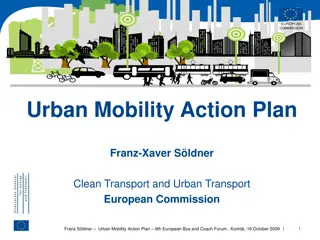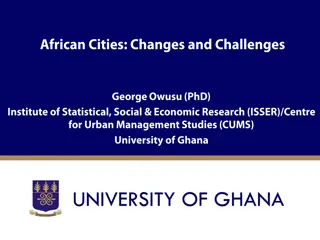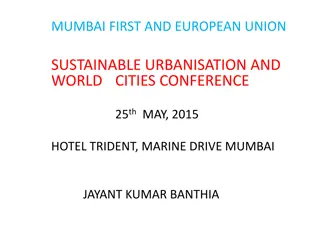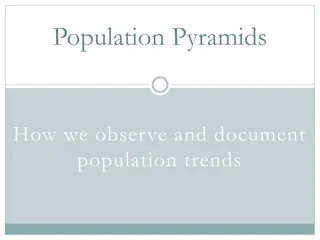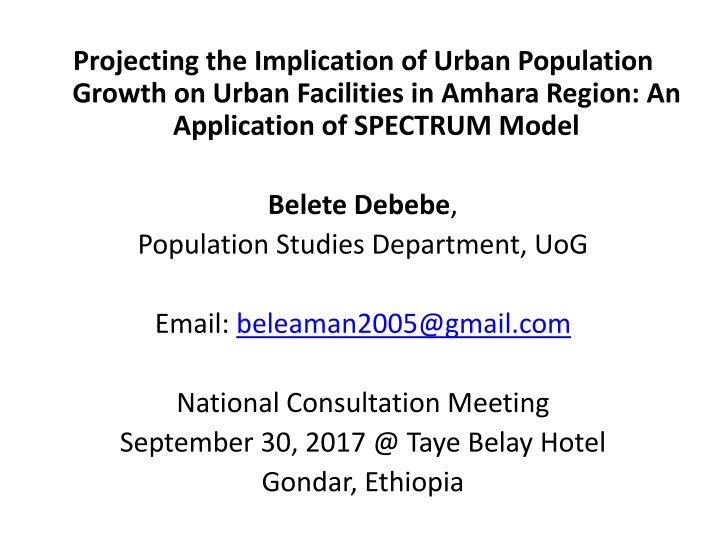
Implication of Urban Population Growth on Urban Facilities in Amhara Region
This study examines the impact of urban population growth on urban facilities in the Amhara Region of Ethiopia using the SPECTRUM Model. It delves into the rapid urbanization trends, housing conditions, and challenges faced by the region in accommodating the growing urban populace.
Download Presentation

Please find below an Image/Link to download the presentation.
The content on the website is provided AS IS for your information and personal use only. It may not be sold, licensed, or shared on other websites without obtaining consent from the author. If you encounter any issues during the download, it is possible that the publisher has removed the file from their server.
You are allowed to download the files provided on this website for personal or commercial use, subject to the condition that they are used lawfully. All files are the property of their respective owners.
The content on the website is provided AS IS for your information and personal use only. It may not be sold, licensed, or shared on other websites without obtaining consent from the author.
E N D
Presentation Transcript
Projecting the Implication of Urban Population Growth on Urban Facilities in Amhara Region: An Application of SPECTRUM Model Belete Debebe, Population Studies Department, UoG Email: beleaman2005@gmail.com National Consultation Meeting September 30, 2017 @ Taye Belay Hotel Gondar, Ethiopia
Presentation Outline Background Objective Methods and Materials Data Sources Methods of Projection Data Analysis Description about the Model Result Implication
Background of the Study the world is rapidly becoming urban. Since 1850 only 2% of the world population lived in cities of 100,000 or more people At present more than (50%) 3.3 billion of world population lived in urban areas. But, the magnitude of urbanization differs in time and place. Hence, urbanization phenomenon It is the outcome of demographic, social, economic, and political development is an inevitable
Background Ethiopia is characterized by a low proportion of urban population, but rapid rate of urbanization compared to other countries in sub-Saharan Africa. The proportion of total population living in urban centers was 6 percent in 1960, 10.4% in 1980, 15% in 2000 and slightly more than 16% in 2007
Background Despite the long history Amhara region remains the least-urbanized region in Ethiopia. Only 12.3 percent of its population lives in urban areas. The majority of living quarters in most cities and towns of the region are nothing more than slums that have mushroomed overnight as people flocking to cities found it impossible to find descent accommodations upon arrival. The quality of available shelter is extremely poor
Background As shown in the 2007 population and housing census Of the total housing units (591,428) in Amhara region urban area about 92% are made of wood and mud Housing Units by Number of Rooms and Average Number of Rooms Per Housing Unit 51% with one room 23.4% have two rooms 15% have three rooms (about 89% have three and below) The rest (about 11%)have more than three rooms
Background Housing Units by Source of Drinking Water 44% of the urban resident their source of drinking water is tap outside compound 24% their source of drinking water was tap in compound shared 13% their source of drinking water was tap in compound private Only 2.4% their source of drinking water tap inside the house The remaining are different sources
Background. Housing Units by Type of Toilet Facility 37.2% have no toilet facility 38% had pit latrine shared 17% had pit latrine private Housing Units of Towns by Type of Kitchen About 35% have no kitchen 57% have traditional kitchen outside the housing unit 6% have traditional kitchen inside the housing unit Only about 2% have modern kitchen inside and outside the housing unit Hence, the effect of increasing urban population is clearly evident in urban areas of the region
Background Urban infrastructures are seriously overtaxed by the burgeoning population, adequate housing, sewerage, electricity, and other services will become more difficult as the population living in cities continues to grow and providing
Background Thus, timely projected data on urban population growth and its consequence development is a key input in order to better assess current and future needs with respect to urban growth and to set policy priorities to promote inclusive and equitable urban development. to systematically track the implication of rapid urban population growth on urban services. on urban
Objective of the Study This study aims to project and raise awareness about the implication of rapid urban population growth on urban development in Amhara region using RAPID module in the Spectrum model from 2007 to 2037 based on hypothetical assumptions.
Data sources Secondary data sources for the base year (refers to the period of 2007) were collected from: Amhara Region Health Bureau and Federal Ministry of Health and Health Related Indicators (2007-2010), Central Statistical Agency, Agricultural Sample Survey (2007-2010), Population and Housing Census of Ethiopia (2007), Amhara Region Urban Development Bureau and other published and unpublished document: annual report, statistical abstract and so on. Then based on data assumption was developed
Methods of Projection RAPID Population Impacts on Development) module in the SPECTRUM model was used to project the social and economic consequences of high fertility and rapid population urbanization and urban development in Amhara region. (Resources for the Awareness of growth on
Data Analysis The data were analyzed using SPECTRUM Suit 4 Model developed by Health Policy Project SPECTRUM is a window-based integrated policy model designed to produce information that is useful for policy formulation to set priorities system of
Model Assumption Two assumed using a demographic projection tool Using RAPID module in the SPECTRUM model; the total urban population, number of population in major cities, annual new urban households and trends of urban youth growth in urban centers in the next 30 years (2007-2037) is projected different population scenarios were
Result The projection result revealed Under slow fertility declining scenario, Amhara region s urban population is projected to increase from 2.4 million in 2007 to 9.1 million in 2037 - an increase of about 7 million which is about four times the 2007 census urban population number Under fast fertility declining scenario, Amhara region s urban population is projected to increase from 2.4 million in 2007 to 8.2 million in 2037 an increase of about 6 million people which almost three times the urban population number of the 2007 census Hence, it is under slow fertility declining scenario, the urban population is projected to grow more.
Total Urban Population with slow and fast fertility scenario
Results In both cases one can notice that the proportion of people reside in urban area of the region is increasing. The increase magnitude of the urban population can have many implication on urban facilities: shortage of housing Currently, a large share of the urban population look for housing solution in the private rental sector or informality by purchasing land from farmers in peri-urban areas the government policies excluded the poor by focusing housing and land supply on: Condominium that are not affordable to the poor Auctions of land leases which do not satisfy the demand Hence, the projection warn and aware government to set priorities and alternative policies on housing
Projected population of major cities in Amhara region The projection result also revealed an increasing tendency of population in major cities Under slow fertility population of major cities is projected to increase from 259,803 in 2007 to 2,786,409 in 2037 Under fast fertility declining scenario, the population of major cities is projected to increase from 259,803 in 2007 to 2,133,227 in 2037. In both cases the annual change rate of the population in major cities in the next 30 years period will be very high declining scenario, the
Projected population of major cities. In only thirty years, the population of major urban centers of the region will be multiplied 4 times. A very rapid growth of population of major cities requires an enormous amount of resources necessary for housing, infrastructure, environmental protection, and more in general for economic development. service, jobs,
Projected urban youth in urban areas of Amhara region (2007-2037) Youth are the region s greatest asset to benefit from the region s demographic dividend for the present and in the future period. They also represent a group with serious vulnerabilities unless serious attention will be taken into consideration by planners and decision makers in the future period. the urban youth population in Amhara region is expected to increase from 821,568 in 2007 to 2.6 million (fast) and respectively by the year 2037, a difference of nearly 300,000 fewer urban youths. 2.9 million (slow),
Projected urban youth Currently, youth unemployment is a serious concern in urban areas of the region due to rural-urban migration, the mismatch between the demand for and supply of labor, the low entrepreneurial capacity of the youth the growing youth population government employment it is the fast fertility declining scenario can help address youth unemployment and related social problems such as crime, violence, and health issues, which can arise when opportunities for urban youth. Thus government has to make advance preparation in need of there is a lack of
Projected annual new urban households The projection result depicted with the slow fertility declining scenario, the annual new urban households between 2007 and 2037 in Amhara region would need about 742,854 new housing units But, with fast fertility declining scenario 499,579 new housing units would require between 2007 and 2037 The projection revealed under fast scenario, the annual number of new urban houses required is projected to grow at a higher rate Hence, government has preparations to deal with the basic needs of its growing new urban households in terms of jobs and housing as well as education and health services. declining to make advance
Projected annual new urban. Rapid urban growth and building new urban houses each year puts continual pressure on urban infrastructure, sanitation, roads and transport, and energy. The associated high housing demand leads to deficits in urban housing, the creation of slums including informal settlement and adverse social and health-related outcomes. including water and
Implication The projection result suggests that the urban population would grow at a higher rate in Amhara region in the coming 30 years. Amhara region has preparations to deal with the basic needs of its growing urban population in terms of jobs and housing as well as education and health services. to make advance
Implication The current (2007) urban population of about 2.4 million is expected to grow to about 8.2 (fast) and 9.1 (slow) million in 2037. This would mean that there would be close to 6-7 million additional urban populations by 2037. Every addition brings new pressure on basic urban service needs which is not financially and technically easily attainable Taking into account the projected population about 2.9 and 2.6 million additional youth population is expected by 2037, which translates into higher demand for jobs and basic social services. Therefore, the government should create an enabling environment for inclusive local economic development that will create jobs and employment opportunities to the youth, among others.
Implication In terms of households, there will be close to 499,579 and 742,854 household for which 499,579 and 742,854 housing units will be required in the coming 30 years with fast and slow fertility declining scenario assuming a one to one household-housing unit ratio In the absence of adequate, affordable urban services a growing population translates into growing urban poverty Failure to address the future demand of housing unit will result in proliferation of informal settlement and of congested slum settlements. additional new urban
Policy Implication Rapid urbanization and urban population growth could severely limit development if it is not managed in such a way that supports economic development and buttresses social welfare improvements. excessively rapid urbanization could out-strip the region s capacity and capability to manage the process of urbanization if appropriate actions are not taken in a timely manner.
References Cohen, B (2006). Urbanization in Developing Countries: Current trends and future projections and key challenges for sustainability. Technology in Society, 28: 63-80 CSA (2008). The 2007 Population and Housing Census. Preliminary Report at National Level, Addis Ababa. Ethiopian Economic Association (2005/2006). Report on the Ethiopian Economy: Unemployment Challenges and Prospects, Volume V. Addis Ababa, Ethiopia. Ministry of Urban Development, Housing and Construction (MUDHCo) (2015a). National Urban Development Spatial Plan - Draft Final report. Selome Bekele and Assefa Hailemariam (2010). Population Dynamics and Environment in Ethiopia: An Overview in Edwards, Sue (ed.), Ethiopian Environment Review no. 1. Forum for Environment, Addis Ababa. Stover, J. and Kirmeryer (2005). DemProj Version 4, a computer program for making Population Projections. SPECTRUM System of Policy Models. Futures Group and Research Triangle Institute, Washington, USA. Tegegn GebreEgziabher (2002). Urban Policy and Strategy in Ethiopia, Report on the 2ndNational Conference on "Urban Development Planning and Implementation: Towards paving the way for partnership, May 14- 16 Adama. Teller and Assefa HaileMariam (2010). The Demographic Transition and Development in Africa: The Unique Case of Ethiopia. UN-HABITAT (2008). The States of African Cities. A framework for addressing urban challenges in Africa, United Nations Human Settlement Program. Nairobi. UN-HABITAT (2010). State of the World s Cities Report, Bridging the Urban Divide United Nations Human Settlements Programme. UN-HABITAT (2011). Integrated Housing Development Program: Condominium Housing In Ethiopia, Nairobi, Kenya. UN-HABITAT (2012b). State of the World s Cities Report 2012/2013: Prosperity of Cities. Nairobi, Kenya: UN-Habitat.


